Managing police schedules is complex, but the right software can make it easier. We review top police scheduling tools built to streamline shift planning, reduce overtime, and improve team coordination.
Juggling 24-hour shift changes, time-off requests, and overtime limits?
The right police scheduling software cuts down on paperwork, keeps your team covered 24/7, and makes scheduling less of a headache.
We’ve rounded up 5 of the best police scheduling apps to help you stay organized, fair, and fully staffed, including:
Our Top Picks
-
Best all-in-one police scheduling software solution for creating and managing your police work schedule
-

Good for police-specific rotation scheduling
-
Good for law enforcement-specific scheduling and personnel tracking
Why trust us?
Our team of unbiased software reviewers follows strict editorial guidelines, and our methodology is clear and open to everyone.
See our complete methodology
17
Tools considered
10
Tools reviewed
5
Best tools chosen
What to Look For in a Police Scheduling Software Tool
I looked for these key features when picking the top tools for police departments and law enforcement teams:
Must-have features
- Flexible scheduling: The software should support 24/7 shift coverage, including rotating shift templates and recurring schedules.
- Time off requests and shift replacements: Officers should be able to easily make requests for time off and shift swaps.
- Overtime tracking: You should be able to monitor and manage overtime fairly and efficiently.
- Task or job scheduling: The tool needs to account for mandatory events outside of regular shifts, like court dates, training, or special assignments.
- Availability tracking: Officers should be able to set when they’re regularly available so it shows on the schedule.
I also made sure the software is:
- User-friendly, with a short learning curve so even non-technical staff can get on board fast.
- Mobile-ready, so officers can check schedules or swap shifts on the go.
Features that really make the app stand out:
- Real-time communication, including shift notifications, alerts, and chat.
- Audit logs and reporting, to support transparency and compliance.
The 5 Best Police Scheduling Software Tools of 2025
-
Connecteam — Best All-in-One Police Scheduling Software Solution.
Connecteam is an all-in-one employee management solution built for frontline teams, including law enforcement. It combines scheduling, communication, task management, and time tracking into one easy-to-use app that works just as well in the field as it does behind a desk.
Here’s what makes Connecteam ideal for police scheduling:
Why I chose Connecteam: I liked that Connecteam handles more than just putting names in time slots. Connecteam makes it easy to schedule shifts, keep everyone in the loop, and manage your team with minimal back-and-forth.
Simple, powerful scheduling
Connecteam’s employee scheduler is built to handle the moving parts that come with police work. Creating schedules was quick and flexible with the drag-and-drop editor, reusable templates, and auto-scheduling feature that matched the right person to the right shift based on availability, skills, and qualifications. I could easily set recurring shifts, assign roles, and plug in all the critical info, like tasks, locations, or shift notes, so every officer knows exactly where to be and what to do.
Making changes on the fly was just as easy. If I needed to update a shift last-minute, I could do it in seconds and the officer would get an instant notification. And if someone couldn’t make a shift, they could release it so another qualified teammate could pick it up. You can also require admin approval for replacements for more oversight.
What really stood out was how Connecteam helped me avoid scheduling mistakes before they happened. It flagged issues like double-booking, scheduling outside someone’s availability, or exceeding hour limits, basically acting like a built-in safety net. And for departments juggling multiple teams or locations, the ability to filter and sort by unit, job type, or location made it easy to stay organized without missing anything.
Overtime management
Connecteam’s time off management offers police departments a simple, mobile-friendly way for officers to request and track PTO. Officers receive instant approval notifications, while supervisors get clear visibility of time off balances and potential staffing conflicts. The system automatically updates leave records and syncs approved time off with schedules and payroll, helping maintain proper coverage and streamline administration. Customizable policies ensure compliance with law enforcement regulations, reducing errors and easing the workload for management.
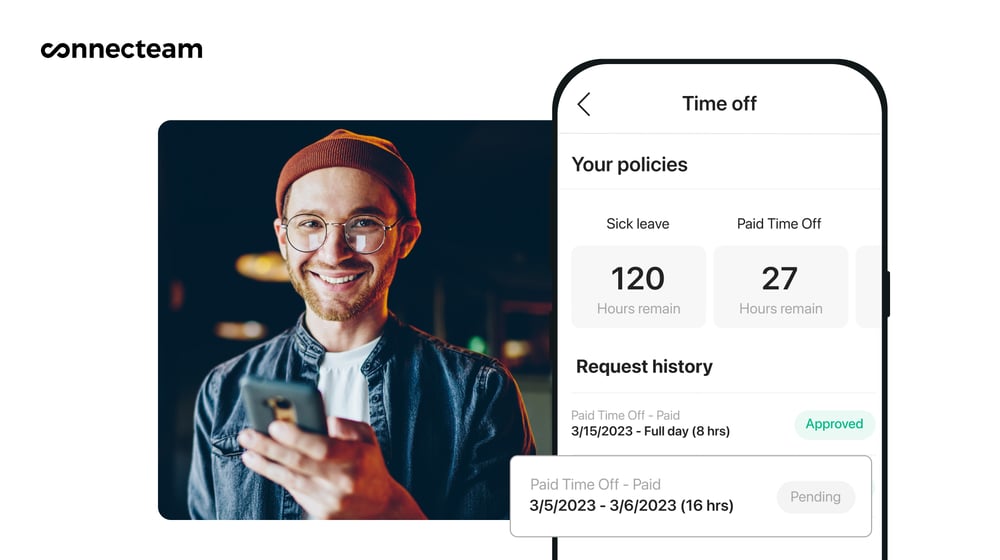
On-the-go communication
I liked using Connecteam’s online team chat to communicate with the team. Whether it’s for a quick shift update, a last-minute location change, or a department-wide policy reminder, you can reach officers in real time without switching platforms or juggling phone lists.
You can easily send direct messages, start a group chat for a specific unit, or push out announcements to the whole department. Everyone gets notified instantly on their phones, so even if they’re out on patrol or not actively checking their schedule, they’re still in the loop.
Mobile time tracking
Connecteam also makes it easy for officers to clock in and out, right from their phones. No need for punch cards, desktop logins, or swing-by check-ins. Whether they’re starting a shift on patrol or finishing up an off-site assignment, they can do it all from the time clock app.
For me, that kind of accessibility is a game changer. It means I’m not chasing people down for timesheets or trying to clean up messy clock-in data. Everything is tracked automatically, including GPS location, so I know when and where each shift started. I can also set rules for things like geofencing or break times, which helps keep everything compliant and fair.
I liked that I could see hours worked in real time, spot overtime as it happens, and make sure everyone is getting paid for the time they actually worked. And when it’s time, all the data is already clean, organized, and ready to go to your integrated payroll provider.
Speaking of integrations…
Connecteam connects with the tools you’re already using and has a built-in API. It offers a solid range of integrations, including:
And much more…
Connecteam goes beyond shift planning, communication, and time tracking. You can also store and manage important staff documents, like certifications, licenses, and training records, all in one place. It’s easy to upload files, set expiration reminders, and keep everything organized by officer. That means no more searching through folders or wondering who’s due for recertification.
And when you need to review what’s been happening, whether it’s hours worked, shift coverage, or attendance, automatic reports make it easy. Everything is logged and ready to go. You don’t have to chase down data or second-guess the numbers. It’s all accurate, exportable, and one less thing to worry about.
Connecteam also offers a free for life plan – Try Connecteam here!
Key Features
- Drag-and-drop scheduler
- Digital timesheets
- Shift replacements
- Real-time notifications
- In-app chat
- GPS time clock
Pros
- All-in-one solution
- Smart auto-scheduling
- Mobile-friendly design
- Advanced admin controls
Cons
- More integrations in development
Pricing
Free-for-life plan availablePremium plans start at $29/month for 30 users
Best All-in-one Police Scheduling Software Solution
Start Scheduling Your Team -

eSchedule — Good for police-specific rotation scheduling
Available on
- Web
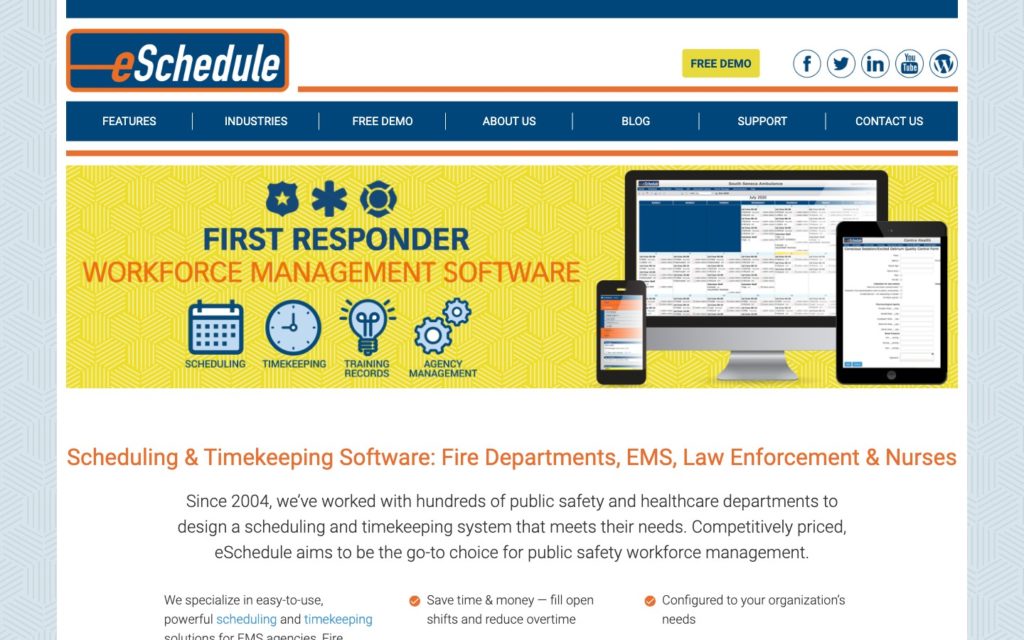
eSchedule is a workforce management platform designed for police and public safety teams. It covers shift planning, time tracking, and communication, built around the unique demands of 24/7 staffing.
Why I chose eSchedule: I liked that eSchedule is made with police departments in mind. It’s a good system that handles complex rotations and non-stop coverage well.
Shift coverage and scheduling
eSchedule handles 24/7 rotation needs with custom shift templates, different units, and role-specific scheduling. It’s flexible once you’ve set it up, but it takes time to dial it in. The interface isn’t very intuitive, so expect it to take some time before you become a pro.
Officers can submit their availability ahead of time, and the AutoScheduler uses that to help fill open shifts. It’s helpful, but not as smart or dynamic as I’d like. I wish it was a more visual, drag-and-drop setup for planning or editing schedules quickly.
There’s also the Events Calendar, which helps prevent scheduling conflicts by integrating mandatory events, like court dates and training, into each officer’s regular schedule, giving both admins and officers clear visibility into upcoming obligations. It gets the job done, but I’d love to see a true two-way sync with existing calendars to save time and avoid duplicate entries.
Shift trades, time off and overtime tracking
Officers can trade shifts using a swap board, which I appreciated. They post a shift, someone else picks it up, and you can approve or reject it. There’s flexibility with how approvals work: some trades can be auto-approved, others require supervisor sign-off, or a mix of both.
Time off requests come through cleanly, but mobile approvals feel clunky. When I’m on the go, I want faster, simpler options, ideally something that lets me approve with one tap.
The system does track hours, PTO, and overtime automatically. I like that you can run reports and use custom pay codes tailored to each department. It simplifies payroll, but I’d like better insight within the tool to prevent overtime before it builds up. It tells me what happened, not what’s about to happen.
Communication and reporting
Officers can log in from their phones to check schedules, swap shifts, and get alerts, but the mobile experience feels like a basic website, rather than a dedicated app. There’s no offline access, and no push notifications, which limits how useful it is in the field.
Communication-wise, eSchedule can send out texts, emails, and department-wide alerts. But there’s no built-in chat, which means you still have to rely on separate apps for quick back-and-forths, which breaks up the workflow.
The system logs everything, including schedule changes, attendance, overtime, and the reporting tools are solid. I found that building custom reports takes more tech skill than it should. And the data’s there, but visualizing it for leadership isn’t easy. Charts and graphs feel like an afterthought.
What users say about eSchedule
eSchedule has been fantastic. I have nothing bad to say about them. They are great for public safety scheduling.
The UI remains outdated in some areas; the events calendar cannot be synced with an external calendar.
Key Features
- Custom rotation scheduler
- Shift trade board
- Time off and overtime tracking
- Availability-based auto-scheduling
Pros
- Strong audit and reporting tools
- Custom pay code support
Cons
- Steep set up and learning curve
- Clunky mobile experience
Pricing
Starts at $5.21/month/user ($1,250/year for up to 20 users) Trial: No Free Plan: No
-
InTime — Good for law enforcement-specific scheduling and personnel tracking
Available on
- Web
- iOS
- Android
- Windows
- Mac
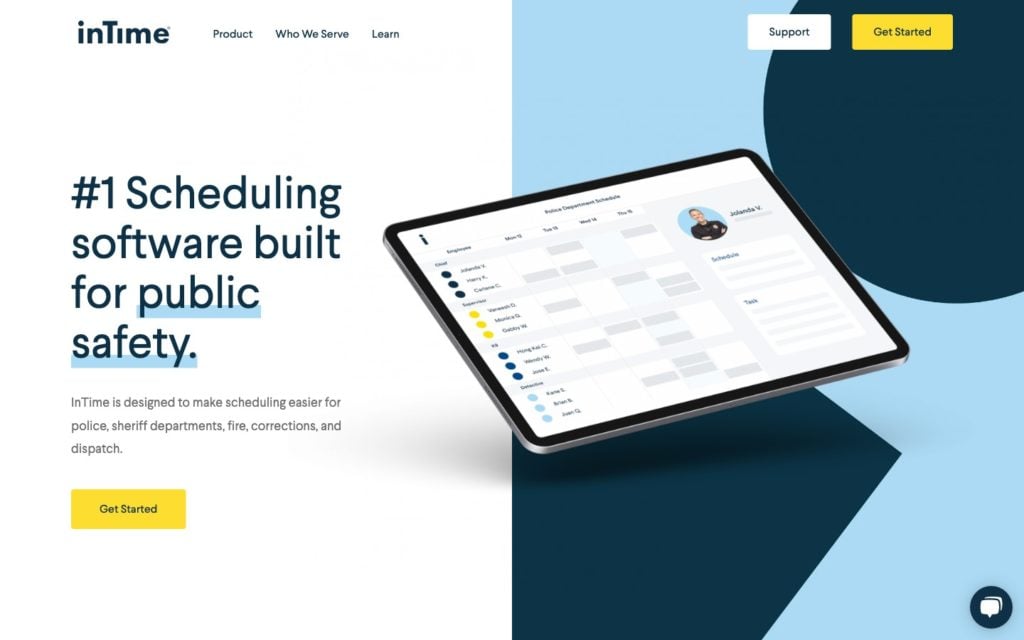
InTime is a comprehensive scheduling platform built specifically for police departments and public safety agencies.
Why I chose InTime: I was impressed by InTime’s automation capabilities and how it aims to simplify overtime management.
Shift coverage and availability
InTime offers a visual approach to scheduling with both team and location views. You can get an overview of all schedules, which helps to spot coverage gaps, fatigue issues, and potential overtime problems before they happen. The system tracks minimum staffing requirements by team, unit, and location, giving you clear visuals of coverage levels.
The interface is more modern than some competitors, and I liked how everything lives in one centralized system. To me, InTime felt more like navigating a color-coded Excel sheet than using a proper scheduling tool. It was packed with information, but the layout felt pretty overwhelming and not very intuitive. It got the job done, but I found myself wishing for a cleaner, more modern experience.
Officers can see all posted assignments and sign up for shifts through both web and mobile. The availability tracking works well, though I wish it had more customizable options for officers to set recurring availability patterns.
Overtime and time off
The automated overtime management is where InTime really shines. You can post overtime assignments and have staff instantly notified through the web or mobile app. Officers can sign up immediately, and the system fills shifts in minutes instead of days. It automatically selects the most qualified personnel based on rules you set up, to help distribute overtime fairly.
For time off, the system streamlines approvals with multiple approval levels and real-time updates. It flags leave requests that would create coverage issues or when officers don’t have enough in their time balances. Once approved, leave is automatically added to the schedule and the officer gets notified.
Communication and reporting
In terms of communication, InTime has automatic notifications for schedule updates, overtime postings, and leave approvals. Officers get instant alerts when their requests are approved or denied, which cuts down on follow-up questions. However, I couldn’t find any built-in chat for direct messaging between team members, which could make it difficult to coordinate quickly or handle last-minute changes without switching to another app.
For reporting, InTime provides good visibility into workforce patterns, though creating highly customized reports still requires some technical knowledge. The system also keeps detailed logs of all schedule changes.
What users say about InTime
Time efficient and user friendly. Essential for scheduling and allowing all members to easily access the info.
The initial learning curve for a new daily scheduler is steep and can be discouraging at first.
Key Features
- Availability and shift signup
- Overtime management
- Staff minimums tracker
- Time off requests
Pros
- Central view for all scheduling
- Real-time shift updates
Cons
- No native chat
- Cluttered interface
Pricing
Contact vendor for price Trial: Yes Free Plan: No
-
PowerTime by PowerDMS — Good for integrating police scheduling with policy and compliance
Available on
- Web
- iOS
- Android
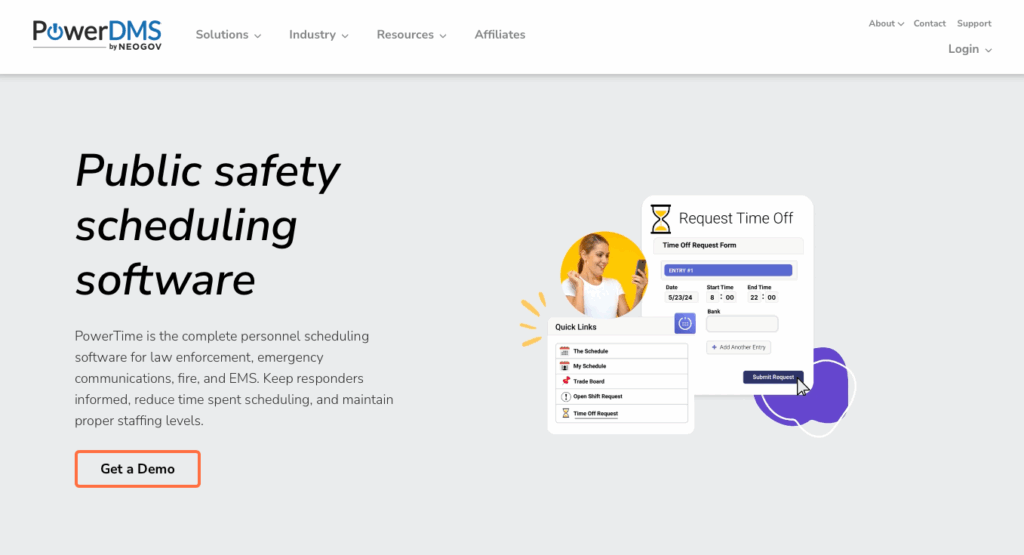
PowerTime by PowerDMS is a personnel scheduling software built specifically for law enforcement, emergency communications, fire, and EMS agencies.
Why I chose PowerTime by PowerDMS: I liked how PowerTime handles complex 24/7 schedules like Pitman rotations and Kelly time.
Shift coverage and scheduling
PowerTime’s scheduling system is designed with public safety in mind, which I immediately noticed when setting up complex rotation patterns. The schedule templates make it surprisingly easy to create and maintain 24/7 coverage. You can build out each officer’s shift or rotation and publish them as far into the future as needed.
I really liked the real-time view of the schedule for the day, week, or month that you can access from mobile or desktop. It was easy to spot coverage gaps, especially because the minimum staffing feature automatically highlights when you fall below required levels.
The system handles day-to-day edits well, like splitting overnight shifts or creating open shifts when someone calls out. However, I did find the initial template setup a big complicated and time-intensive. Visually, the schedule is very basic, but clean.
Time management
The time off request system is pretty straightforward. Officers can submit requests from anywhere, and the system automatically flags if a leave request would create coverage issues.
For shift trades, the trade board makes the entire process more transparent. Officers can see available shifts and request trades without constant admin involvement, but you can still maintain approval oversight.
Overtime management works similarly. You can post open shifts when you’re short staffed or need extra coverage for a special event, and qualified officers can claim it. to minimum. What seems to be missing is just more advanced analytics for overtime distribution and forecasting, which would help with budgeting.
Notifications and reporting
Staff can receive alerts within the app, or via email and text message about important schedule changes or updates.
PowerTime has good audit trails of all schedule changes, overtime submissions, and approvals. You can export data for payroll processing, but it’s difficult to create highly customized reports.
Key Features
- Rotation pattern templates
- Time off management
- Minimum staffing alerts
- Trade board for shifts
Pros
- Good for staying compliant
- Accessible on mobile
Cons
- No way to set availability
- In-app communication is limited
Pricing
Contact vendor for price Trial: No Free Plan: No
-

Snap Schedule 365 — Good for customizable scheduling and reporting features
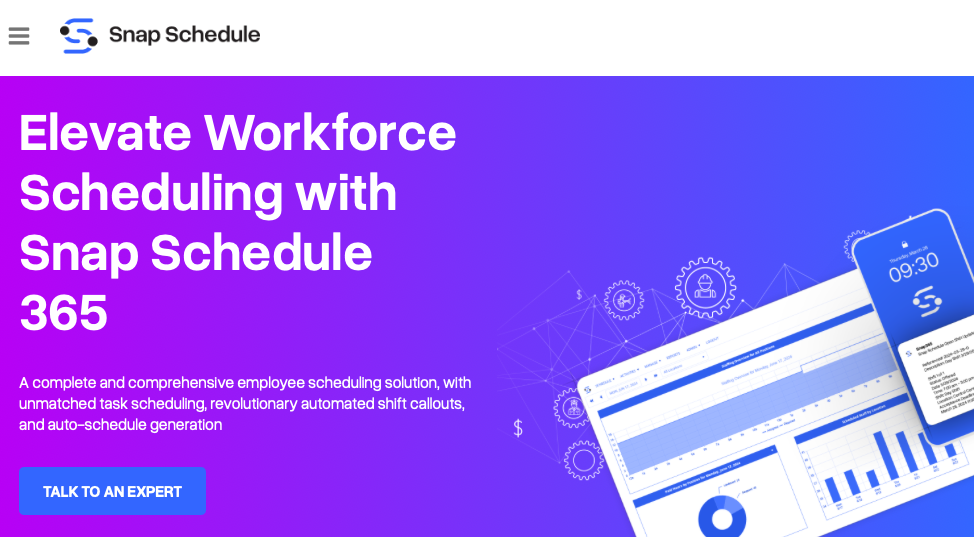
Snap Schedule is a workforce scheduling software that offers a powerful set of features to manage complex shift patterns.
Why I chose Snap Schedule: I like Snap Schedule for its auto-scheduling capabilities and built-in shift conflict detection. It’s a good fit for police because it flags overlapping shifts, excessive overtime, and certification mismatches to maintain compliance.
Shift scheduling
Snap Schedule lets you build detailed shift templates and use an auto-scheduler to fill shifts based on availability, skills, and certifications, which I liked. The system’s conflict detection highlights scheduling errors before publishing to reduce the risk of understaffed or improperly assigned shifts.
Setting up these templates (“plans”) and schedules isn’t super intuitive, and the outdated interface didn’t help. I thought the schedules looked cluttered, with too many details crammed in. Also, there are no automatic alerts about new or updated schedules. Instead, notifications pile up within the app, and managers have to manually review and send them out, which I found a bit inconvenient.

Snap Schedule uses color coding for different types of shifts. Open shift coverage
One of Snap Schedule’s standout features is its automated call out management, which fills unexpected coverage gaps. When an officer calls out or a shift opens at the last minute, the software identifies qualified and available personnel based on customizable criteria such as skills, certifications, and hours worked. It then automatically contacts these officers via email, text, or push notifications to offer the open shift.
Snap Schedule also supports shift bidding and trading, giving staff some flexibility to swap shifts via a trade board. Managers can control approvals to ensure fairness and operational needs are met.
Time tracking and mobile access
Snap Schedule has basic time tracking features that allow officers to clock in and out, either manually or via integrated time clocks. However, the time tracking module is fairly basic and doesn’t include advanced biometric options or GPS tracking. There is a geofence function, but I found it difficult to set up, especially because it doesn’t show you a map.
Overtime is closely monitored, with alerts for shifts exceeding labor budgets or maximum work hours, which I found helpful. While effective, Snap Schedule doesn’t have advanced analytics for forecasting overtime costs, which could be valuable for departmental budgeting.
In terms of accessibility, officers need an additional subscription to access the mobile app. The app itself is only for employee use, which I didn’t love. There’s no way for a manager or supervisor to edit or update a schedule on the go, which I can see being an obstacle.
What users say about Snap Schedule
It often includes tools to help ensure compliance with labor laws, helping businesses avoid scheduling conflicts and potential legal issues.
The only downside is that the payroll and cost reports could be more customizable so they can be tailored to our specific business.
Key Features
- Shift scheduling
- Auto-shift callout
- Time tracking
- Overtime management
Pros
- Geofencing available
- Shift bidding and trades
Cons
- Added subscription for mobile app
- No automatic update notifications
Pricing
Starts at $37.50/month + $3/user/month for mobile access Trial: Yes — 30-day Free Plan: No
Compare the Best Police Scheduling Software Tools
| Topic |
 Start for free
Start for free
|

|
|
|

|
|---|---|---|---|---|---|
| Reviews |
4.8
|
4.8
|
4.8
|
4.8
|
4.4
|
| Pricing |
Starts at just $29/month for the first 30 users
|
Starts at $5.21/month/user ($1,250/year for up to 20 users)
|
Contact vendor for price
|
Contact vendor for price
|
Starts at $37.50/month + $3/user/month for mobile access
|
| Free Trial |
yes
14-day
|
no
|
yes
|
no
|
yes
30-day
|
| Free Plan |
yes
Free Up to 10 users
|
no
|
no
|
no
|
no
|
| Use cases |
Best All-in-One Police Scheduling Software Solution.
|
Good for police-specific rotation scheduling
|
Good for law enforcement-specific scheduling and personnel tracking
|
Good for integrating police scheduling with policy and compliance
|
Good for customizable scheduling and reporting features
|
| Available on |
Web
|
Web, iOS, Android, Windows, Mac
|
Web, iOS, Android
|
What Is Police Scheduling Software?
Police scheduling software is a digital tool that helps law enforcement agencies plan, organize, and manage officer schedules. It replaces manual spreadsheets, paper rosters, or basic calendar tools with a more structured, centralized system that handles 24/7 coverage, rotating shifts, overtime, and team availability.
Many of these platforms are designed for public safety environments, where staffing gaps, overlapping roles, and high-stakes accountability require precision. A good police scheduling tool makes it easier to assign the right people to the right shifts, avoid conflicts, and keep the entire department on the same page.
How Does Police Scheduling Software Work?
Most police scheduling software has a digital dashboard where administrators can build and view shifts. From there, you can create templates, track officer availability, set staffing minimums, and assign shifts to individuals or units. Many tools also flag scheduling conflicts, double-bookings, and overtime risks before the schedule is published.
Once a schedule is finalized, it can usually be shared directly with officers via web or mobile apps. Officers can view their assignments, request time off, or pick up extra shifts—all within the same system. This real-time access helps reduce miscommunication and no-shows.
More advanced platforms also offer built-in time tracking, leave management, automated overtime rules, and reporting tools. Some integrate with payroll and HR software for easier workforce management.
The Benefits of Police Scheduling Software
The main benefits of using law enforcement scheduling software include:
Time-saving
Manually building officer schedules is tedious with plenty of room for mistakes. Police scheduling software automates most of the process, from shift templates to availability tracking. This frees up hours of admin time every week that can go back into fieldwork or strategic planning.
Improved shift coverage
Police officer scheduling makes sure every shift is properly staffed. The best tools track minimum staffing levels and identify gaps before they become problems. You can also match shifts to officer qualifications, roles, or unit types, which helps reduce risk and improve response readiness.
Adapt on the fly
In law enforcement, plans change constantly. Whether it’s sick leave, court dates, or emergencies, scheduling software helps you adapt quickly. Most tools let officers request changes from their phone and send real-time alerts when something shifts, so you’re never caught off guard.
Reduce burnout and errors
Smart scheduling tools help you spot problems early, like overtime buildup, unbalanced workloads, or staff fatigue. You can view total hours, adjust assignments, and stay compliant with internal policies or labor rules. These systems also catch common mistakes, such as double-booked shifts or scheduling someone past their hour limit. With fewer errors and more oversight, you reduce risk, avoid disputes, and keep your team running smoothly.
Gain insight from reports
Many platforms turn scheduling and attendance data into reports. Whether you’re tracking court appearance hours, overtime trends, or staffing gaps, it’s easier to present data to leadership and make informed decisions.
How Much Does Police Scheduling Software Cost?
Pricing for police scheduling software varies widely depending on the size of your team and the features you need. Most solutions charge either per user or per feature tier, and costs can range from $1,000 to $75,000+ per year. Some providers also charge onboarding or setup fees.
For smaller departments or those with tighter budgets, cost can be a real obstacle. Connecteam offers a completely free Small Business Plan for up to 10 users, which includes core scheduling, time tracking, and communication tools. It’s one of the only solutions that gives you full functionality without breaking the bank.
FAQs
The best schedule balances coverage and officer wellness. Many departments prefer 12-hour shifts with 2–3 consecutive days off. Using tools like Connecteam makes it easier to manage rotations and reduce fatigue.
Most police officers work rotating shifts to maintain 24/7 coverage. Common patterns include 8-, 10-, or 12-hour shifts, often alternating between day, evening, and night duty over a set cycle.
Police departments use CAD (Computer-Aided Dispatch) systems for managing calls, dispatching units, and logging incidents. They also use tools like Connecteam for scheduling, time tracking, and communication.
The Bottom Line on Police Scheduling Software
Creating a police work schedule doesn’t have to be a manual, time-consuming task, especially with purpose-built scheduling software designed for law enforcement.
With the right tool, you can improve coverage, reduce errors, track time accurately, and give your officers real-time access to their schedules, all while improving communication and accountability across the team.
Our list of top police scheduling tools is a great place to start. But if you’re looking for the most complete, mobile-friendly, and cost-effective option, Connecteam stands out as the smartest choice for departments of all sizes.





